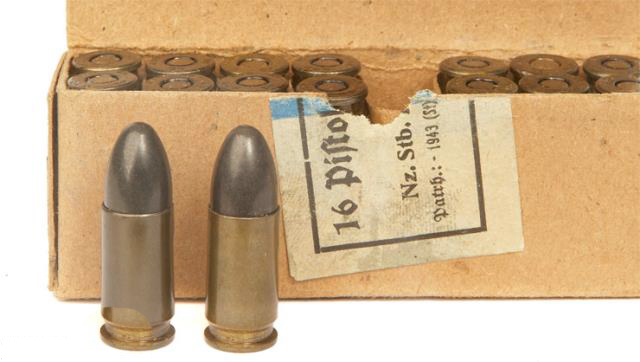Notwithstanding that the Wehrmacht, the united armed forces of Nazi Germany from 1935-1946, commited some of the worst large-scale atrocities the world has ever seen, many people today are fascinated with this military machine on account alone of its technological accomplishments. After all, Germany’s engineers and designers during that period paved the way to the future with innovations in infrared technology, guided weapons, small arms, and even the humble 9×19 mm Parabellum cartridge.
Even today, the number of 9×19 variations developed by Nazi Germany remains a matter of speculation. This much is certain: Germany used a tremendous amount of 9×19 during the war, and developed an impressive variety of specialized loads to suit the myriad applications of the cartridge.
The most abundant of the German WWII 9mm loads is 124 grain ball, which would have been used in anything from a Luger to an MP 40. During the prewar and early war periods, this cartridge typically had a brass case and a round nose, a lead-core bullet, and a muzzle velocity of about 1,083 FPS, or perhaps a little higher. Jackets were copper, or alloy. Finding ammo from this period on the modern market is generally not easy.
Instead, if you’re looking for a box or two to add to your collection, you’re far more likely to encounter mid- to late-war German 124 grain ball. The load data approximates that of prewar ammo, but outwardly there are some differences: Most of the later 9×19 ammo has a lacquered steel case, and an alloy jacket instead of a copper one. It often also has a steel core, but where “steel” can mean sintered iron, mild steel, or a fairly good grade of hard steel. Materials shortages meant that certain luxuries exited the scene fairly early on, and serious modifications were made out of necessity. As a collector of German WWII 9mm you will find a vast array of types and makes on the market. You’ll encounter many familiar names when you examine the headstamp codes, but you’ll also come across some obscure manufacturers, often from occupied countries.
The most prominent of Germany’s WWII 9mm specialty loads is a tracer round, which troop leaders often used to direct the firepower of their machine gun-centric units. By loading a tracer every few rounds into an MP 40 magazine, an NCO or officer could effectively “point” while firing to shift the fires of his men. This ammunition is relatively rare on the market today. Individual boxes or rounds can be found, but cases are absolute unicorns.
Germany also produced a super-hot 9mm blank that Wehrmacht troops employed to ignite the stream of fuel from a particular variant of the Flammenwerfer 41 flamethrower. The user would first spray the target with fuel, then pull the operating lever back another click to fire one of these cartridges from a magazine located in the wand. Of the FmW 41s I’ve seen on the market over the years, this is the more common of two main variants, with the other featuring a pilot light.
Another noteworthy specialty load is Germany’s 9×19 subsonic, intended for use with suppressed weapons. A suppressor actually was made for the MP 40, and it did see some action. I had an opportunity to fire an original MP 40 fitted with an original suppressor, although not with original subsonic ammunition. For its age, it did a more than adequate job suppressing standard 115 grain ball. The original subsonic 9mm product, labeled “Nahpatronen,” is difficult to find, but does occasionally turn up on the modern market.
If you’re into German WWII technical oddities, such as the advanced aircraft designs that never made it beyond the draft concept stage, and the supposed “Wunderwaffe,” then the 9×19 Raketenpatrone will appeal to you. The Raketenpatrone was Germany’s attempt to create a 9mm cartridge with a tiny, built-in rocket motor in lieu of a case, so that nothing would be left behind upon firing. If you’ve been thinking the H&K G11 is the ultimate in “Teutonic Space Magic,” you might want to reconsider. Decades earlier, Opa (Grandpa) was already working on caseless ammo and 5,000-RPM roller-locking machine guns.
